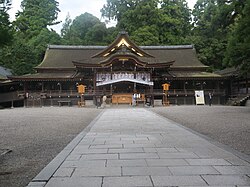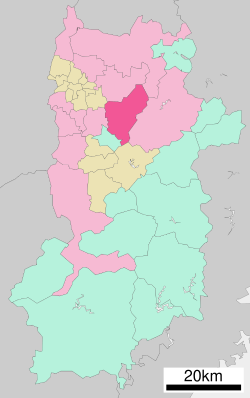Sakurai, Nara
|
Sakurai 桜井市 |
|
|---|---|
| City | |

View of Omiwa Shrine, one of sightseeing spots in Sakurai
|
|
 Location of Sakurai in Nara Prefecture |
|
| Coordinates: 34°31′N 135°51′E / 34.517°N 135.850°ECoordinates: 34°31′N 135°51′E / 34.517°N 135.850°E | |
| Country | Japan |
| Region | Kansai |
| Prefecture | Nara Prefecture |
| Government | |
| • Mayor | Akira Hasegawa |
| Area | |
| • Total | 98.92 km2 (38.19 sq mi) |
| Population (December 28, 2011) | |
| • Total | 60,705 |
| • Density | 613.68/km2 (1,589.4/sq mi) |
| Time zone | Japan Standard Time (UTC+9) |
| Postal code(s) | 633-8585 |
| - Tree | Cryptomeria |
| - Flower | Prunus jamasakura |
| Phone number | 0744-42-9111 |
| Address | 432-1 Ōaza Ōdono 633-8585 |
| Website | City of Sakurai |
Sakurai (桜井市 Sakurai-shi?) is a city located in Nara Prefecture, Japan.
As of April 1, 2015, the city has an estimated population of 58,436, and 24,389 households. The population density is 613.68 persons per km², and the total area is 98.92 km².
Sakurai was briefly the capital of Japan during the reign of Emperor Yūryaku. The life of the Imperial court was centered at Hatsuse no Asakura Palace where the emperor lived in 457–479. Other emperors also built palaces in the area, including
The modern city was founded on September 1, 1956.
Sakurai is home to Ōmiwa Shrine, traditionally considered one of the oldest Shinto shrines in Japan dedicated to the god of sake. Sake dealers across Japan often hang a wooden sugi ball, made at Ōmiwa Shrine, as a talisman to the god of sake. It was featured in Yukio Mishima's novel Runaway Horses.
...
Wikipedia

